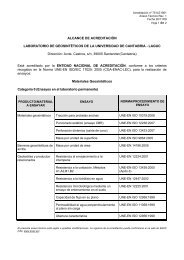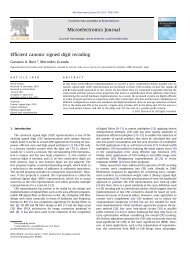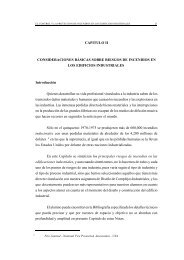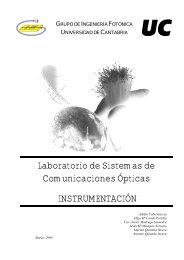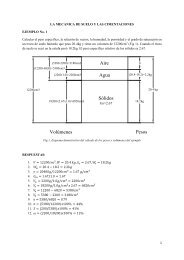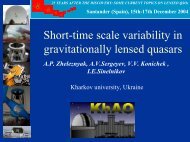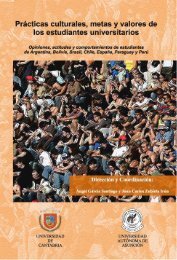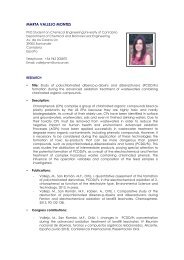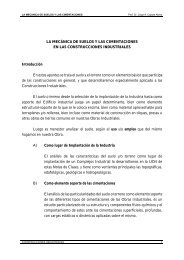designing optimal spatial meshes: cutting by parallel trihedra ...
designing optimal spatial meshes: cutting by parallel trihedra ...
designing optimal spatial meshes: cutting by parallel trihedra ...
You also want an ePaper? Increase the reach of your titles
YUMPU automatically turns print PDFs into web optimized ePapers that Google loves.
JOURNAL OF THE INTERNATIONAL ASSOCIATION FOR SHELL AND SPATIAL STRUCTURES: IASSDESIGNING OPTIMAL SPATIAL MESHES: CUTTING BYPARALLEL TRIHEDRA PROCEDUREJ. L. Alvaro, C. OteroDpmt. of Geographical Engineering and Graphical Expression Techniques.Civil Engineering Faculty. University of Cantabria. Spain.SUMMARYThis work proposes, under the title of “<strong>cutting</strong> <strong>by</strong> <strong>parallel</strong> <strong>trihedra</strong> or pyramids”, a procedure that makes theintersection of spherical <strong>spatial</strong> <strong>meshes</strong> possible in such a way that new vault shaped polyhedra can be obtainedand under <strong>optimal</strong> conditions. Each face of this type of body is a patch of spherical dome the breakdown ofwhich is known; this breakdown places some edges along minor circles in the sphere. Some photorealisticimages of designs based on the <strong>parallel</strong> <strong>trihedra</strong> procedure are shown.The Parallel <strong>trihedra</strong> procedure does not make a really new breakdown of the sphere but it selects which Scaleof the sphere can be used to make intersections with some others.Keywords:1. INTRODUCTIONThe essential idea is that the well known breakdownof the spherical icosahedral triangle shown infigures 1 to 4 can be understood from two differentconsiderations:i) In the slab ABA 1 B 1 , the string of edges A 1 B 1belongs to a great circle in the sphere,ii) In the slab ABA 1 B 1 , the string of edges A 1 B 1belongs to a minor circle in the sphere, not agreat one.The latter is the case sketched in these figures,because the other one has been profusely studiedand it will be known <strong>by</strong> the reader. If the secondapproach is considered, some strings of bars areplaced on minor circle arcs into the breakdown ofthe spherical mesh; therefore, a huge scope ofpossibilities appear, because it is then possible todesign intersections of spheres, <strong>cutting</strong> each otheralong these circles. These spheres have well knownrhythms of decomposition. In this paper, differentcontributions of other researchers are applied withrespect to the <strong>cutting</strong> procedure into a sphericaltriangle (we mean some classical studies andproperties, i.e. references [3], [4], [6], [7] and [8]).Thus, the present contribution intends to illustratethe usefulness of those previously describedproperties to design intersections of spherical<strong>meshes</strong> and shows how far their application can go.This work starts with some geometricconsiderations proposed in [1], [2] and publishedunder the title “Cutting <strong>by</strong> <strong>parallel</strong> <strong>trihedra</strong>”, for<strong>designing</strong> the geometry of <strong>spatial</strong> <strong>meshes</strong> shaped asintersections of groups of spheres, in such a waythat the distribution of nodes, edges and panels is<strong>optimal</strong> (the latter, understood as proposed in [3] or[4]). The considerations in paragraphs 2 and 3summarize the procedure; paragraphs 4 and 5contain an applied formulation of some previouscontributions; paragraph 6 shows some new designsof <strong>spatial</strong> <strong>meshes</strong>.Figure 1
VOL. 41 (2000) n. 1332. CUTTING BY PARALLEL TRIHEDRAConsideration 1. We will refer to the sphere{O, R} as the one circumscribed to the regularicosahedron; starting from the spherical triangleABC (see fig. 1), which has its centre in O and isrelated to a face of the regular icosahedron, thetrihedron OABC is defined. Point M, on the spherecircumscribed to the polyhedron, defines with O anorder-3 rotation symmetry axis on the generatedshape ABC.Consideration 2. Let it be OM and let us considernew vertices of <strong>trihedra</strong> O 1 , O 2 , etc. (see fig. 2)<strong>parallel</strong> to OABC on it. They make new sphericalpatches A 1 B 1 C 1 , A 2 B 2 C 2 , etc. on the sphericaltriangle ABC. Every one of them is bounded <strong>by</strong> anarc A 1 B 1 , A 2 B 2 , etc. of minor circle on the formersphere {O, R}.Figure 2PROPERTY I. A distribution of edges as the oneshown in fig. 3 is <strong>optimal</strong> (the number of elements,nodes, panels and edges is minimum [3]) if thelength of edges along the arc AB, A 1 B 1 , A 2 B 2 , etc.(and their symmetric BC, B 1 C 1 , B 2 C 2 , etc.CA, C 1 A 1 , C 2 A 2 , etc.) have the general expressionl i = R i ·? , where ? is the only degree of freedom, l iis the length of the edge along the arc A i B i and R i isthe radius of the circle holding the arc A i B i .Obviously, all the bars on an A i B i string have thesame length.PROPERTY II. Having assumed these conditions,the distances OO 1 , O 1 O 2 , O 2 O 3 , etc. needed forplacing the vertexes O 1 , O 2 , O 3 of the <strong>parallel</strong><strong>trihedra</strong> are defined [1].Figure 3PROPERTY III. The value of the parameter ? isrelated to the number n of bars proposed forapproaching the geodesic arc AB. Indeed, it resultsin: ? =arc(AOB)/n. From here, the rest of thegeometric parameters needed for defining the patchis obtained, more or less, immediately (the readercould find it in [1] or [5]). Once the grid is solved, itturns out that the sequence of distances OO 1 , O 1 O 2 ,O 2 O 3 , etc. becomes convergent and the number ofbars on the arcs AB, A 1 B 1 , A 2 B 2 , etc. produce anarithmetic succession of ratio –3. The last string, onthe arc A n B n is closed with 1, 2 or 3 bars, depending Figure 4
JOURNAL OF THE INTERNATIONAL ASSOCIATION FOR SHELL AND SPATIAL STRUCTURES: IASSon the number n proposed at the beginning. Therange of length of edges obtained <strong>by</strong> this type ofdiscreetization result to be especially favorablewhen the starting polyhedron is the regularicosahedron; however, the procedure is useful forany other regular one, with the same properties butlosing the excellent range of length in the bars.PROPERTY IV. Following with an associatedicosahedron, its own symmetry properties make thejoin of <strong>trihedra</strong> as the OABC around the vertex Opossible: 20 of them make up the dome. We shouldremember that any position for the vertexes O 1 , O 2 ,O 3 , etc. does not generate an <strong>optimal</strong> mesh butsolves the problem (see fig. 4); when the situationof them is chosen according to PROP I and III, the<strong>spatial</strong> mesh also has that feature: its balance ofelements is <strong>optimal</strong> [1].PROPERTY V. Let the trihedron O i A i B i C i ,obtained during the latter procedure, be considered(see fig. 5). Since it is <strong>parallel</strong> to OABC, it has in O ithe same solid angle ? /5; again, the union around O iof 20 similar <strong>trihedra</strong> O i A i B i C i creates a closedsurface made <strong>by</strong> 20 spherical triangular patches theboundaries of which are now minor circle arcs. Inother words, a shape composed <strong>by</strong> the intersectionof 20 spheres the intersection lines of which are allarcs identical to A i B i . Notice that every one of these20 equal patches is a SCALE of knowndiscreetisation (prop. I to IV). This idea ofconstructing <strong>meshes</strong> based on scales has beenproposed in [2] in this same bulletin. In figure 6 itcan be seen that, once again, the placement ofvertexes can always be discretionary but onlyaccording to prop III, the balance of elementsremains <strong>optimal</strong>.Figure 5PROPERTY VI. Let us, at last, consider again therhythm of generation of the <strong>parallel</strong> <strong>trihedra</strong>proposed in fig. 2. The sequence of vertexes O igradually approaches to M from O; however, wecan propose some other O-1 , O-2, O-3 , etc withthem moving away. In this latter group, anypreviously described property is lost; the newness isthat the resulting mesh is more vault-shaped thanthe first one.Figure 6
VOL. 41 (2000) n. 133Figure 7 Figure 8Figures 9 and 103. CUTTING BY PARALLEL PYRAMIDSFigures 7 and 8 show the most immediate designsderived from the previous point. Both are preparedfor indicating the general shape of the structure anddefining the boundary lines in every scale, once it iswell understood that the grid of triangles alwaysfollows the rules explained previously. Indeed, thebasis of the procedure “<strong>cutting</strong> <strong>by</strong> <strong>parallel</strong> <strong>trihedra</strong>”is the same when another starting regularpolyhedron is selected because the high number ofsymmetry plans and rotation axes and thepossession of a circumscribed sphere are, in fact,the features that make it possible to apply it.Furthermore, figures 9 and 10 are new modelsderived from semi-regular polyhedra; when one ofthese bodies is chosen to start the procedure, there
JOURNAL OF THE INTERNATIONAL ASSOCIATION FOR SHELL AND SPATIAL STRUCTURES: IASSarise as many families of <strong>parallel</strong> pyramids asdifferent types of face the body has; similarly, asmany different radii of spheres as different faces. Ageometric demonstration of the compatibility of twoor more different <strong>parallel</strong> pyramids (compatibilityalong their common boundary) for making up thistype of mesh is found in [1] or [5]. Summarising,the condition of compatibility allows only a radiusof sphere to be a degree of freedom. For example,starting from the rombicosidodecahedron (3-4-5-4:1 triangle, 2 squares and 1 pentagon around eachvertex) there are three different spheres but thevalues of two of them depend on the third. Therelation is proposed in the indicated references.4. A STUDY WITH RESPECT TO THEGENERATION OF GRIDS INTO THESCALES CREATED BY PARALLELPYRAMIDSAt least, regular and semi-regular polyhedra causenew <strong>meshes</strong> shaped as intersections of spheres. Donot forget that, in all of them, the balance ofdifferent elements is <strong>optimal</strong>. Now, we can focus onthe internal triangulation:REMARK I. Whatever polyhedron is used as astarting body, every obtained scale accepts manydifferent grids of triangles so that there are always afamily of bars approaching the boundary arcs andtheir <strong>parallel</strong>.REMARK II. The <strong>optimal</strong> grid in a scale dependson the polihedron used for starting the procedure.Figure 11-a summarises the <strong>optimal</strong> pattern R1proposed <strong>by</strong> [3] (ref. [6], [7] and [8] for moredetail); this is used for making the distribution ofbars at point 2 and can be thus typified so:Feature I. The type a bars, on the arc AB, have alength R·? (R is the radius of the spherecircumscribed to the icosahedron); the type b bars,on the arc A 1 B 1 , have a length R 1·? (R 1 is the radiusof the <strong>parallel</strong> circle holding A 1 B 1 ), the type c bars,on the arc A 2 B 2 , have a length R 2·? and so on.Feature II. If there are n type a bars, there are (n-3)type b, (n-6) type c, etc.Feature III. The slab ABA 1 B 1 holds type a, b, x andy bars (with the same applying for its symmetricBCB 1 C 1 and CAC 1 A 1 ). Type x bars connect a nodeon AB with one in A 1 B 1 . There are three type ybars, connecting nodes on the main arcs AB, BCand CD. This scheme remains on the slabsA 1 B 1 A 2 B 2 , etc.Feature IV. The string of type a bars approaches thearc AB (BC and CA); that of b bars, the arc A 1 B 1(B 1 C 1 and C 1 A 1 ) and so on.A possible alternative grid R2 is shown in figure11-b, where:- Feature I remains.- Feature II has changed: if there are n type abars, there are (n-1) type b, (n-2) type c, etc.- Feature III has changed: the slab ABA 1 B 1 holdstype a, b and x bars but there are not type y bars.- Feature IV remains.Figure 11-a Figure 11-b
VOL. 41 (2000) n. 133Figure 12 Figure 13This second grid gives a worse balance of elementsthan the first one when the starting polyhedron isthe regular icosahedron, but becomes better when,for example, we decide start from thedodecahedron. The question is: are there more validgrids, provided that their edges on the arcs AB,A 1 B 1 , ... A i B i , etc. carry out the condition l i = R i·?proposed in REMARK I, point 3?.The question has this solution (see fig. 12; moredetail in [7]):- Take the arc AM and apply to it a rotation ofvalue a around the axis OE, perpendicular to theplane OAB: the arc passing over the nodes Aand a 1 has resulted.- Reiterate the rotation and new arcs passing overa and b 1 , b and c 1 , etc. has resulted.- Take the arc BM and repeat again, having therotation a value -? . A grid is done.This Fundamental Grid (from now on, we will referit as FG) accepts the pattern of triangulation R 1(figure 13), R 2 (figure 14), and many others(i.e. figure 15). Again, the solution does not dependon the starting polyhedron but on their geometricproperties. As FG exists in all the regular and semiregularpolyhedra, the law of composition obtainingR 1 , R 2 or any other is valid for all of them. Only oneis, for each case, the most suitable in terms ofoptimisation but, in this article, we are driving ourFigure 14 Figure 15
JOURNAL OF THE INTERNATIONAL ASSOCIATION FOR SHELL AND SPATIAL STRUCTURES: IASSconsiderations to the design of general shapes made<strong>by</strong> intersection of spheres. We will do it,understanding now that a scale obtained <strong>by</strong> meansof the <strong>parallel</strong> pyramids procedure has alwaysdefined an FG and that we do not need any detailconcerning on its final triangular grid.We finish this point adding this remarks:PROPERTY VII. Whatever starting polyhedron isused, the FG is not defined in the whole of one ofits faces but: in a third part if it is a triangle, aquarter if it is a square, etc. The rotation symmetryon the centre of the face lets complete over it.PROPERTY VIII. FG is always applied on aspherical isosceles triangular patch.Figure 165. RHOMBIC SCALESOnce again, we use the regular icosahedron as thebasis of a new proposal: considering the isoscelestriangle ABM and using the plan OAB as asymmetry one, it is created a non planar rhombiABMN which associated spherical scale is definedfrom its Fundamental Grid. The pyramid OABMNcan be treated <strong>by</strong> means of the “<strong>parallel</strong> pyramids”method (see fig. 16): moving the vertex O along theaxis OP, we can obtain a new pyramid OA 1 B 1 M 1 N 1(see fig. 17) <strong>cutting</strong> the sphere circumscribed to theicosahedron according to a new spherical patchA 1 B 1 M 1 N 1 which boundaries are arcs of minorcircles. Being e = OE, the line perpendicular to theplan holding the face OA 1 B 1 (the same holds theface OAB), and taking e as a rotation axis, a newFundamental Grid is defined where is feasible topropose some different triangulation patterns, as wehave shown on the last point. So:Figure 17- It is possible to triangulate the scale OA 1 B 1 M 1 N 1under the same conditions and considerationsproposed on the point 1.- The scale A 1 B 1 M 1 N 1 can be related to the edgeAB of the icosahedron, in such way that the joinof 30 scales shapes a closed surface made <strong>by</strong> theintersection of 30 spheres with the same radius.At least, regular and semi-regular polyhedra can bethe starting body in order to obtain a <strong>spatial</strong> meshmade <strong>by</strong> intersection of spheres and discreetizableFigure 18
VOL. 41 (2000) n. 133Figure 19Figure 20<strong>by</strong> means of its own Fundamental Grid, whichallows different patterns of triangulation.Whichever polyhedron it is, the scale produced isrhombic-shaped (starting with a regular polyhedra)or rhomboid-shaped (starting with a semi-regularone). Figures 19 and 20 shows different views of asolution derived from the icosahedron (the roof hasonly 10 scales); its fundamental grid, but notriangulation, is drawn over it.6. CONCLUSIONThe <strong>parallel</strong> <strong>trihedra</strong> (or pyramids) procedure makespossible the intersection of spheres in such a waythat new “inflated polyhedra” can be designed. Thefollowing summary-table shows the type ofobtained <strong>spatial</strong> mesh, when the starting polyhedronis regular.Similarly, 14 semi-regular polyhedra generate asmany inflated and rhombic models. In short, 28 newshapes made up <strong>by</strong> scales of sphere, <strong>cutting</strong> eachother along arcs of minor circle. Their internal gridof triangles is, nevertheless, always <strong>optimal</strong>.
JOURNAL OF THE INTERNATIONAL ASSOCIATION FOR SHELL AND SPATIAL STRUCTURES: IASSSTARTINGPOLYHEDRONINFLATEDPOLYHEDRONSKETCHRHOMBICSOLUTIONSKETCHREGULARTETRAHEDRONREGULAROCTAHEDRONCUBEREGULARDODECAHEDRONREGULARICOSAHEDRON
VOL. 41 (2000) n. 133REFERENCES[1] Otero C. “Diseño geométrico de cúpulas noesféricas aproximadas por mallas triangularescon un número mínimo de longitudes debarra”. Ph. D. University of Cantabria.Santander. 1990.[2] Otero C. et al. “Classical Geometry in flat andsimple curved <strong>meshes</strong>”. I.A.S.S. Bulletin,Vol 33, nº 1. 1992.[3] McConnel R. E., Phil D. “Networkoptimization of curved space structures”. ThirdInternational Conference of Space Structures,Guilford (England). Elsevier Applied SciencePub. London. 1984.[4] Tarnai T. “Optimization of spherical networksfor geodesic domes”. Third InternationalConference of Space Structures, Guilford(England). Elsevier Applied Science Pub.London. 1984.[5] Otero C. , Otí J. “Manipulando escamas decúpula geodésica”. IV Congreso internacionalde Expresión Gráfica en la Ingeniería. Libro deactas. Madrid. 1992.[6] Tarnai, T. Spherical grids of triangularnetwork. Acta Technica AcademiaeScientiarium Hungaricae 76. 1974. Pp 307-336.[7] Pavlov, G. N. “Compositional form-shaping ofcrystal domes and shells. Geometric essays ongeodesic domes”. Hungarian Institute forBuilding Science. Budapest, 1987. Pp. 9-124.[8] Stuart D. R. On the orderly subdivision ofspheres. The student Publications of TheSchool of Design, North Carolina StateUniversity (Rayleigh) 5, No 1 1954. Pp 23-33.



